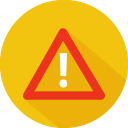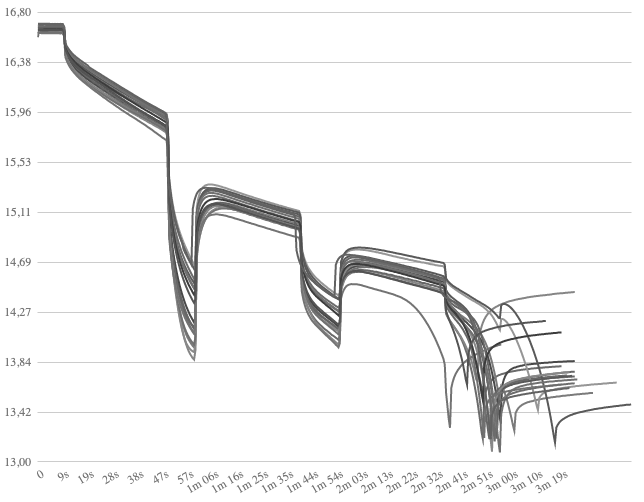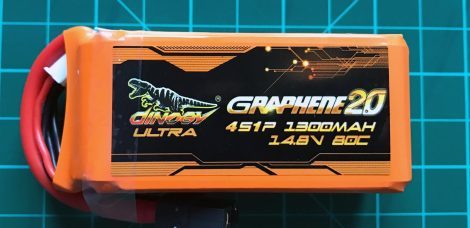I am proud to present you my battery review of the all new Dinogy MEGA Graphene 2.0 series. The new MEGA product line tries to pair the great power delivery of the ULTRA series pack with a highly competitive pricing. This review looks at the 1350 mAh version of the MEGA Graphene 2.0 battery.
Appearance
The all new Dinogy* MEGA family is rated up to 75 C and therefore can be classified below the current ULTRA Graphene 2.0 line up (80 C) performance wise. The outer appereance of the pack only changed with regards to colors used. Instead of the bright orange on the ULTRA series, the MEGA batteries come in an all red styling, which is made of the honey comb-style material we have seen on the front and back of the ULTRA series*. Top and bottom show the four black lithium polymer cells inside as L&E uses transparent shrink wrapping on the new product. Beside the 1350 mAh there also is a 1550 mAh version available, which I will have a look at some when in the near future.


Technical Design
The Dinogy* MEGA Graphene 2.0 75 C pack is a standard 4S1P config flight pack for high power use. It utilizes the new generation graphene cell chemistry. An extra layer of carbon particles is added to minimize internal resistance and hence maximize possible current draw. The newest version now is rated up to 75 C constant. We will rate the performance later.
Build Quality: Very good. Pack feels very well made on the outside. Connection terminal looks solid. The bright redhoney-comb materials feels like it offer good protection on the sides. The new transparent shrin wrap is nice to look at. The golden sticker at the bottom adds to the overall quality feel of the product.
Plugs: The Dinogy pack comes with standard XT60 connectors* equipped – again in black color.
Cables: L&E uses 12 AWG wires on this packs. The high flexible silicon layer is rated up to 200°C. Cable length is about 7.0 centimeters.
Balacing plugs: Standard XT-system*. Balance wires are rather short (2.5 cm) which is a benefit in terms of getting them out of the prop-range on the aircraft. Main power line and balancer wires are connected at the top of the pack.
Technical Details
| Manufacturer | L&E Battery Industrial* |
| Type | Dinogy MEGA Graphene 2.0 75C |
| Cell chemistry | Lithium Polymere (LiPo) |
| Cell type | Dinogy Graphene enabled chemistry |
| Cell count | 4 |
| Pack configuration | 4S1P |
| Capacity | 1350 mAh |
| Max. Charge Current | 10.8 A (8 C) |
| Max. Discharge Current Continuous Burst | 101.25 A ? A |
| Weight w/o plugs with plugs | – ca. 158 grams |
| Measurements as listed measured | 35 x 34 x 70 mm 34.3 x 34.6 x 70 mm |
| Price | US-$ 28 |
| Note | This battery has been directly donated by the manufacturer / distributor for review purposes. |





Break-in documentation
The battery followed the standard break-in-process: The pack is charged at a rate of 1C until CV-phase ends with current of 1/10C. The break-in phase consists of four charging cycles at 1C and four corresponding discharges at 1 C / 4C / 10C and 20 C.
Anomalies: No anomalies during break-in.
Internal resistance measurements during break-in phase
| Cycle | Cell 1 | Cell 2 | Cell 3 | Cell 4 | Total |
| After first charge | 1.4 | 1.5 | 1.0 | 1.4 | 5.3 |
| After second charge | 1.8 | 0.7 | 1.3 | 1.7 | 5.5 |
| After third charge | 1.7 | 1.6 | 0.6 | 1.4 | 5.3 |
| After fourth charge | 1.4 | 1.8 | 0.9 | 1.6 | 5.6 |
Charging process
CV-Phase is short on this cell type. Balancing in normal mode took 1:46 min. Cell drift during charge was unobtrusive. This is for 1C charge (1.4 A).
Load Testing
The main part of this battery test will consists of different load test settings showing the battery performance. Constant load testing is used to judge the advertised C-ratings as well as look at cell drift under high loads. We also check on internal resistance once more. Next up is the dynamic current test, which simulates a „real“ flight with changing (=dynamic) loads. For test methodology please check the dedicated methodology page!
Constant Load Testing
Constant load testing follows a certain load pattern of different constant currents. Base load is 10 C. Current pulses at 50 C, 35 C, 20 C and 30 C are maintained for time intervals between 10 and 20 seconds. For more details please refer to the test methodology page.
Capacity Usage
During this test the pack delivered 984 mAh. This is 72,8 % of nominal capacity. A very good result.
Average cell voltages
The following table lists the average voltages per cell, of the total pack, as well as the averaged value per cell as fraction of total voltage during phase of active load.
| Cell 1 | Cell 2 | Cell 3 | Cell 4 | Total | Average per cell | |
| Avg. Voltages | 3.764 V | 3.761 V | 3.769 V | 3.767 V | 15.061 V | 3.765 V |
Just looking at average values the Dinogy pack performs good. All cells stayed well above 3,7 V on average. An average value above 3,74 V / cell can be considered very good.
Focus Voltages
Exceptionally interesting when testing a battery under a constant load for a longer period of time: the lowest voltage per cell just before load impulse is disabled. On top, you should have look at voltage recovery rate, that is: how fast do cell voltages rise again once load impulse is cut.
| Phase | Cell 1 | Cell 2 | Cell 3 | Cell 4 | Total |
| End of 50 C | 3.630 V | 3.630 V | 3.653 V | 3.668 V | 14.58 V |
| End of 35 C | 3.574 V | 3.573 V | 3.586 V | 3.586 V | 14.325 V |
| End of 20 C | 3.244 V | 3.257 V | 3.314 V | 3,359 V | 13.174 V |
| End of 30 C | – | – | – | – | – |
Voltage sag is very low on the Dinogy MEGA 1350 mAh pack. No cell went below 3,5 V/cell benchmark on first two load cycles. Great result!
Average voltage recovery per second
Those values are specific to the test setting and not valid for the pack in general! Still they allow an estimated guess about how fast voltages rise again after current spikes.
| Cell 1 | Cell 2 | Cell 3 | Cell 4 | Total | |
| Avg. Recovery | 0.0285 V / s | 0.0280 V / s | 0.0255 / s | 0.0230 V / s | 0.1051 V /s |
Voltage recovery is quick for the new MEGA Graphene 2.0 1350 mAh 75 C battery.
IR-Measurement
IR measurement is conducted using the four current pulses. Resistance for each cell is calculated in all four discharge phases. Shown values are averaged to cancel out different temperature points due to different discharge states during measurements.
| Cell | 1 | 2 | 3 | 4 | Total |
| Resistance [mΩ] | 2.42 | 2.41 | 2.13 | 2.33 | 9.29 |
Interpretation: The internal resistance of 2.32 mΩ average per cell indicates a „true“ C-rating of around 44 C (59.1 A). This is on the conservative side and represents a current draw that will make the pack last for a long time. Overall performance can be described as very high!
Cell drift under load
| Discharge Phase | 50 C | 35 C | 20 C | 30 C |
| Max Cell drift (V) | 0.013 V | 0.021 V | 0.155 V | – |
Cell drift is low on the new Dinogy MEGA Graphene 2.0 75 C packs during main discharge phase. Cells are matched well. I expect even better matching once batch production is up and running, as more cells for perfect matching will be available in the factory.
Key Temperature Facts

Temperature Development
Max. temp during discharge was around 50.2 °C on top of pack. Note that heating of stressed LiPo packs will continue for some more time even when load is cut.
Market Comparison
The following chart shows all reviewed LiPos in the same product segment for direct comparison of performance. Higher values under load are better.
Constant 25 C Discharge
Pretty much a standard benchmark in the LiPo industry.
Cut-Off /warning value for this battery should be chosen 3.5 V minimum. After this point voltage drops quick. The battery provided 920 mAh (68,1 %) during the 25 C discharge.
Market Overview
Comparison of different reviewed 1300 mAh batteries under 25 C load.
Dynamic Load Testing
The dynamic load testing setting consists of two separate discharge scenarios that have been developed of two different real-life FPV flights. Pattern one represents a high speed low proximity flight around the open field with some hovering to the end. Average load is around 22 A. Second pattern is a free-style flight around trees in the park with some current spikes near 70 A. Average load on this flight is around 13 A due to longer floating periods.
Capacity Usage
During the test of pattern 1 the pack delivered 1018 mAh. This is 75.1 % of nominal capacity. Very good. In patter 2 testing 986 mAh (73.0 %) could be used until first cell reached cut-off voltage.
Market Comparison
The following charts give an overview of all tested packs in the 1300 mAh class so far.
The last chart of this review sums up the usable capacity during all four load scenarios. Please note that this is only the capacity consumed by the electronic load! There are losses due to heating of the pack, which could be approximated (see testing methodology page). All four tests are cut when any cell goes below cut-off voltage of 3,3 V (or pack goes above 58 °C on any of the three probes). If you would push further and go down to 3,0 V/cell you will be able to squeeze out some mAh more, but at the cost of excessive heat generation and shortening of pack life-span. This value will most likely differ from what you get when flying on a quad as most people don’t monitor voltage on a per cell basis and therefore don’t even notice if voltage drops below 3,3 V/cell during punsh-outs (what’s not necessarily a good thing, though). For comparison, used capacity until 3,3 V/cell is reached is the base line in all battery reviews on Drone-Zone.de.
Conclusion
The new generation of 75 C MEGA Graphene packs are an interesting piece of tech. I like to see the weight drop by almost 20 g compared to the current ULTRA Graphene 2.0 80 C 1300 mAh* battery. Luckily Dinogy managed to keep the excellent built quality, we all got used to. I still think it is fair to say that Dinogy lipos are one of the best manufactured battery brand a the moment. No wonder you won’t see any puffing or deformation of the battery even under high loads. Heat is spread evenly across the pack and the shape is kept at all times. The cell matching is not as good as on the current ULTRA products, but I guess this will improve once production runs at full scale – in comparison to other products the matching is still good, though. Nothing to worry about here. I would rate this pack at true 44 C, which is really good and amounts to 59 A continuous load capabilities. Cut-off should be chosen at 3,5 V / cell minimum. The sticker on the pack tells you 3,4 V/ cell but this would mean to cut of throttle immediately after you hear your telemetry or buzzer complaining. As expected usable pack capacity comes in behind the current ULTRA series*, but is still decent. The best is yet to be announced: Pricing for the 1350 mAh Dinogy* MEGA 4S 75 C pack starts at US-$ 28. Therefore the MEGA series is a great choice for training and free style flying at a reasonable price! For that kind of money Dinogy once more has to offer an excellent performance-to-price ratio in the high quality- high performance lipo market.
Other packs of this line up tested:









